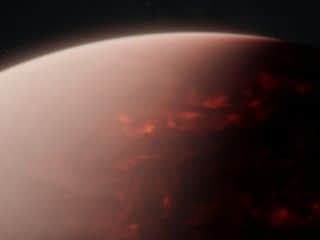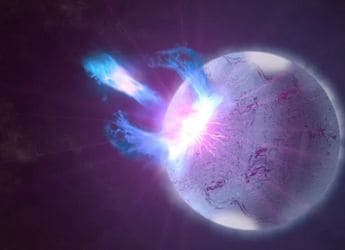- Home
- Science
- Science News
- Webb Telescope Confirms Planet Forming Disks Last Longer in Early Universe
Webb Telescope Confirms Planet-Forming Disks Last Longer in Early Universe
Webb Telescope confirms planet-forming disks persisted for millions of years in early universe environments.

Photo Credit: NASA, ESA, CSA, STScI
James Webb's image of NGC 346 shows a star cluster with ten surveyed stars marked.
The NASA/ESA/CSA James Webb Space Telescope has verified a decades-old mystery regarding planet formation in the early universe. According to The Astrophysical Journal, findings indicate that planet-forming disks around stars endured far longer than previously theorised, even in environments with minimal heavy elements.
Reportedly, in 2003, the NASA/ESA Hubble Space Telescope observed the presence of massive planets around ancient stars. This was surprising as these stars lacked heavier elements like carbon and iron, essential for planet formation. The discovery raised questions about how such planets could form and grow so early in the universe's history.
Revisiting a Longstanding Puzzle
To explore this further, the Webb Telescope focused on NGC 346, a massive star cluster in the Small Magellanic Cloud. As one of the Milky Way's nearest neighbours, its chemical composition, dominated by hydrogen and helium, closely resembles conditions in the early universe. The cluster's stars, estimated to be between 20 to 30 million years old, were found to retain planet-forming disks far beyond the expected timeframes seen in our galaxy.
Findings Challenge Existing Models
Guido De Marchi, study lead from the European Space Research and Technology Centre (ESTEC), stated to ESA sources that they see that disks indeed surround these stars and are still in the process of gobbling material, even at the relatively old age of 20 or 30 million years. This finding challenges current models, which predict that planet-forming disks dissipate within a few million years. Elena Sabbi, co-investigator and chief scientist at NOIRLab's Gemini Observatory, explained in a statement that models suggested disks would not survive in environments with low metal content. Webb has now proven that planets in such conditions can form and evolve for longer periods.
Why Do Disks Persist Longer?
Two possible explanations have been proposed for the extended lifespans of these disks. The first suggests that radiation pressure, which typically disperses disks, is less effective in environments with minimal heavier elements. These elements are needed for radiation to interact with the surrounding gas efficiently.
The second explanation considers the initial size of gas clouds. Stars forming in low-metal environments might originate from larger clouds of gas, leading to bigger disks. Larger disks take significantly longer to disperse, providing more time for planet formation.
Implications for Planet Formation Theories
These observations provide new insights into planet formation in the early universe, indicating that planets may have had extended growth periods even under conditions once thought unfavourable. With Webb's unprecedented resolution, astronomers now have tangible evidence that planet-forming disks are far more resilient than previously understood, reshaping long-standing theories about planetary evolution.
Get your daily dose of tech news, reviews, and insights, in under 80 characters on Gadgets 360 Turbo. Connect with fellow tech lovers on our Forum. Follow us on X, Facebook, WhatsApp, Threads and Google News for instant updates. Catch all the action on our YouTube channel.
Related Stories
- Samsung Galaxy Unpacked 2025
- ChatGPT
- Redmi Note 14 Pro+
- iPhone 16
- Apple Vision Pro
- Oneplus 12
- OnePlus Nord CE 3 Lite 5G
- iPhone 13
- Xiaomi 14 Pro
- Oppo Find N3
- Tecno Spark Go (2023)
- Realme V30
- Best Phones Under 25000
- Samsung Galaxy S24 Series
- Cryptocurrency
- iQoo 12
- Samsung Galaxy S24 Ultra
- Giottus
- Samsung Galaxy Z Flip 5
- Apple 'Scary Fast'
- Housefull 5
- GoPro Hero 12 Black Review
- Invincible Season 2
- JioGlass
- HD Ready TV
- Laptop Under 50000
- Smartwatch Under 10000
- Latest Mobile Phones
- Compare Phones
- Vivo S50 Pro Mini
- Vivo S50
- OPPO Reno 15c
- Redmi Note 15 5G
- Redmi Note 15 Pro 5G
- Redmi Note 15 Pro+ 5G
- Lava Play Max
- Poco C85 5G
- Asus ProArt P16
- MacBook Pro 14-inch (M5, 2025)
- OnePlus Pad Go 2
- Poco Pad M1
- Just Corseca Skywatch Pro
- Honor Watch X5
- Acerpure Nitro Z Series 100-inch QLED TV
- Samsung 43 Inch LED Ultra HD (4K) Smart TV (UA43UE81AFULXL)
- Asus ROG Ally
- Nintendo Switch Lite
- Haier 1.6 Ton 5 Star Inverter Split AC (HSU19G-MZAID5BN-INV)
- Haier 1.6 Ton 5 Star Inverter Split AC (HSU19G-MZAIM5BN-INV)

















